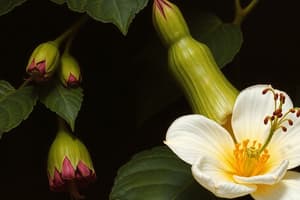Podcast
Questions and Answers
What is the primary function of petals in flowers?
What is the primary function of petals in flowers?
- Supporting the stigma
- Protecting the flower bud
- Producing pollen
- Attracting pollinators (correct)
What is the term for the fusion of male and female gametes to produce seeds?
What is the term for the fusion of male and female gametes to produce seeds?
- Fertilization (correct)
- Fusion of gametes
- Seed formation
- Pollination
What is the benefit of cross-pollination in flowering plants?
What is the benefit of cross-pollination in flowering plants?
- Increased genetic diversity (correct)
- Decreased seed production
- Reduced adaptation
- Slowed evolution
Which part of the flower produces pollen?
Which part of the flower produces pollen?
What is the result of the fusion of gametes in flowering plants?
What is the result of the fusion of gametes in flowering plants?
Which of the following is NOT an agent of pollination?
Which of the following is NOT an agent of pollination?
What is the term for the growth of the zygote into an embryo?
What is the term for the growth of the zygote into an embryo?
What is the function of the stigma in flowers?
What is the function of the stigma in flowers?
What is the importance of sexual reproduction in flowering plants?
What is the importance of sexual reproduction in flowering plants?
Flashcards are hidden until you start studying
Study Notes
Sexual Reproduction in Flowering Plants
Overview
Sexual reproduction in flowering plants involves the fusion of male and female gametes to produce seeds.
Structure of Flowers
Flowers are the reproductive structures of flowering plants, consisting of:
- Petals: colorful, attracting pollinators
- Sepals: green, protecting the flower bud
- Stamen (male):
- Filament: stalk supporting the anther
- Anther: produces pollen (male gametophytes)
- Carpel (female):
- Stigma: receptive surface for pollen
- Style: connects stigma to ovary
- Ovary: contains ovules (female gametophytes)
Process of Sexual Reproduction
- Pollination: transfer of pollen from anther to stigma
- Fertilization: fusion of male gamete (sperm) with female gamete (egg cell)
- Fusion of gametes: formation of a zygote
- Embryo development: growth of the zygote into an embryo
- Seed formation: embryo develops into a seed, surrounded by endosperm and seed coat
Types of Pollination
- Self-pollination: pollination within the same flower or plant
- Cross-pollination: pollination between different flowers or plants
- Agents of pollination: insects, birds, bats, wind, and water
Importance of Sexual Reproduction
- Genetic diversity: increased variation in offspring
- Adaptation: adaptation to changing environments
- Evolution: driving force behind evolution of flowering plants
Studying That Suits You
Use AI to generate personalized quizzes and flashcards to suit your learning preferences.




